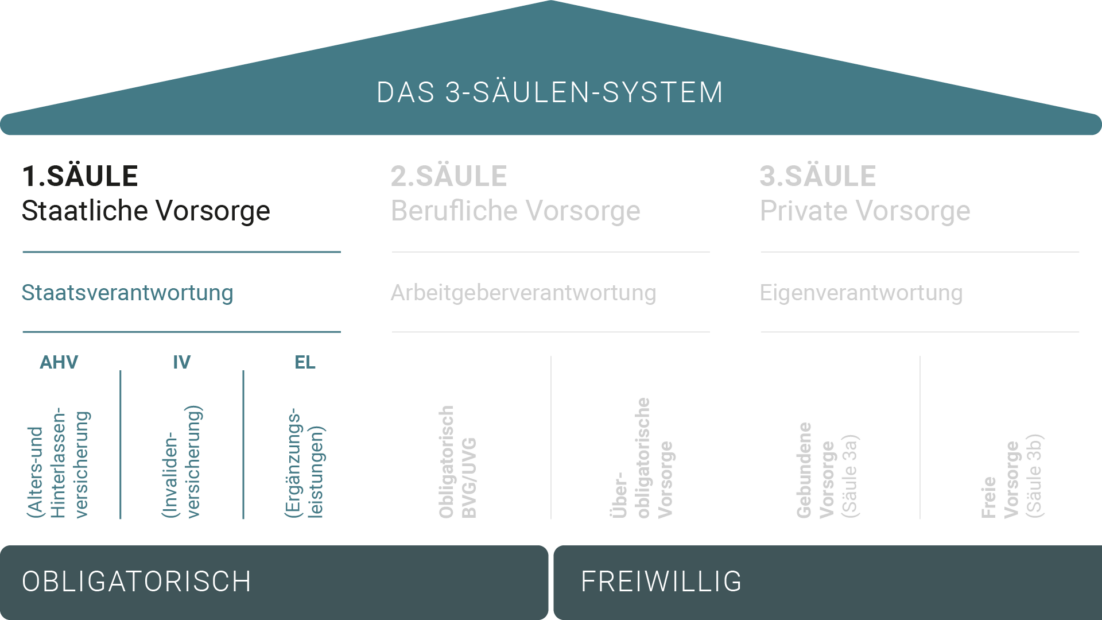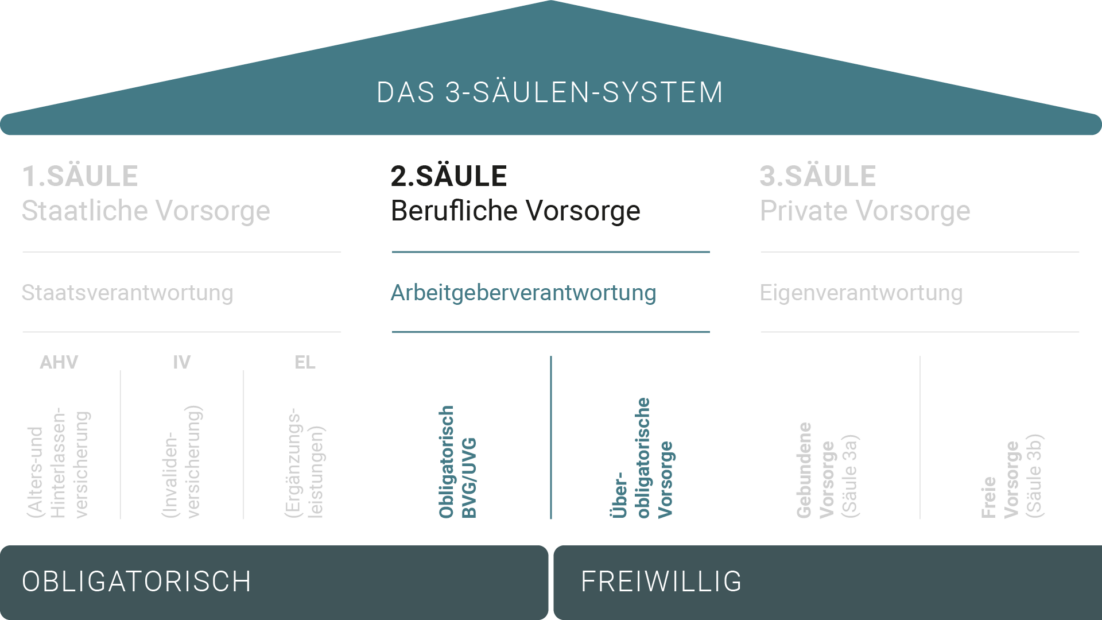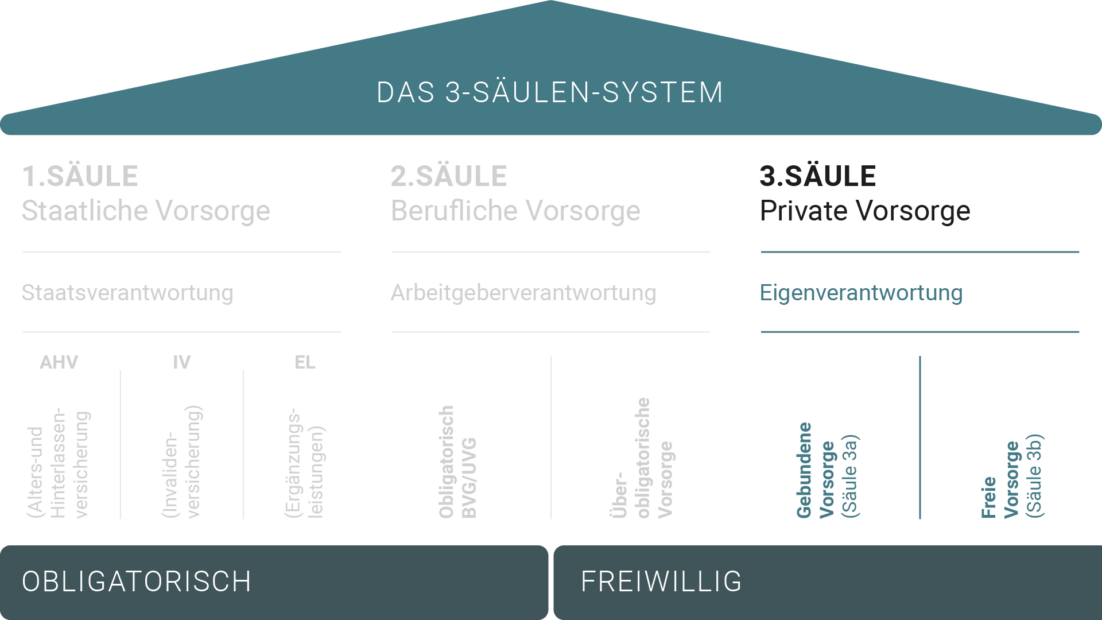The basis for material security in Switzerland is the 3-pillar principle. It is the pension system guaranteed by the Federal Constitution and has proven itself over several decades. The aim is to provide Swiss citizens with financial security in old age and in the event of disability. In addition, dependents should be covered in the event of death.
Demographic developments and persistently low-interest rates also pose major challenges for Switzerland. Nevertheless, spreading the responsibility over several pillars makes pension provision more stable. This makes it all the more important for each individual to know the instruments, the specialists involved, and their areas of expertise. This article is intended to serve this purpose and provide an overview of the individual possibilities.
Contents
- 1 The most important facts in brief
- 2 The story: A social insurance system is created by referendum
- 3 Structure and operation of the 3-pillar principle
- 4 Pillar 1: Securing your livelihood – the state pension plan
- 5 Pillar 2: Occupational pension provision – a building block for securing the standard of living
- 6 Pillar 3: Private pension provision – secures the accustomed lifestyle in old age
- 7 Unrestricted pension provision 3b: Individuality through a variety of financial products
- 8 Identify gaps in pension provision in good time and adapt pension provision forms
- 9 The strengths of the Swiss pension system in an international comparison
The most important facts in brief
- Switzerland’s pension system consists of three pillars: state, occupational and private pension plans.
- The first pillar serves to secure subsistence and is the responsibility of the state.
- The second pillar comprises occupational benefits and is the responsibility of employers.
- With the third pillar, personal responsibility is called for. With this, a private pension can be built up with state support.
- The opportunities that arise with the offers within the third pillar are interesting for several reasons. On the one hand, tax advantages already present themselves during active working life. On the other hand, this is about the possibility of avoiding unpleasant income gaps. The goal is to maintain the lifestyle in old age to which you have become accustomed.
- Spending on your private pension plan will be easier the sooner you start.

The Health and Accident Insurance Act (KUVG) came into being as early as January 1, 1912. Four decades later, the Old-Age and Survivors Insurance (OASI) was created on January 1, 1948. The two world wars were major triggers for this insurance. Many soldiers and their families were in dire straits because they were no longer able to work due to wounds. Families also experienced economic hardship due to the death of their main breadwinner.
It took many parliamentary initiatives before a nationwide solution was found. In 1960, the insurance was supplemented by disability insurance.
Many years later, the 3-pillar principle was enshrined in the Federal Constitution. On December 3, 1972, the Swiss voted in favor of the model with a 74 percent majority. For the first time in the history of Switzerland, a clear system was created that offered the population protection against the risks of disability, old age, and death of the main provider.
Before social insurance became part of public law in Art. 111 ff. of the Swiss Federal Constitution (BV), there were various institutions for this purpose. They were associations of persons as well as institutions to which people in distress could turn. These included, for example, welfare for the poor, mutual aid societies, and private insurance companies.
Structure and operation of the 3-pillar principle
The system is one of the fundamental values of Switzerland. It guarantees social security on a collective level and enables people to live a life of self-determination in old age. This objective is a major challenge in its implementation. Finally, all pension systems are subject to demographic change and have to face a changing society.
In Switzerland, this means in particular:
- Every generation so far has enjoyed a seven-year increase in life expectancy.
- 46 percent of Swiss citizens say they want to build up a nest egg for their old age.
- The challenge of the pension gap: This affects one in three Swiss citizens.
Despite the need for adjustments, Switzerland still has an excellent starting position. The basis for this is the 3-pillar principle, in which each pillar fulfills its specific purpose and has its scope of benefits. The interaction stands for classic Swiss values: solidarity as well as personal responsibility.
The first pillar includes only mandatory benefits. Likewise, some of the second pillar insurances are standard. Another part of the second pillar covers is voluntary options. The third pillar is based on completely voluntary benefits with its private insurances.

Pillar 1: Securing your livelihood – the state pension plan
The first pillar is based on the principle of solidarity. Employees (including cross-border commuters) and employers pay monthly contributions, which finance the payments to current pensioners. The age for the OASI pension, the retirement age, is currently 65 for men and 64 for women. The pension is granted upon application. If you want to know how much pension you can expect, you can apply to the cantonal compensation office for an advance calculation.
As of January 1, 2021, the maximum OASI pension is CHF 2,390 per month, and you can expect a minimum of CHF 1,195. These pensions require the full contribution period.
With this pillar, Switzerland fulfills its duty as a welfare state. In old age and the event of disability, the beneficiary’s livelihood is secured. However, you cannot expect more from the first pillar.
Features 1st pillar
The main features of the first pillar are:
- mandatory pension plan
- performances:
- Old-age and survivors’ insurance (OASI)
- Disability insurance (DI)
- The supplementary benefits (EL) for OASI and DI
- Unemployment insurance (ALV)
- Maternity allowance (MSE)
- EO (according to the income replacement regulation, benefits during military service, civil defense, or civilian service)
- Objective: Securing livelihood
- Financing: pay-as-you-go system (paid in by employed persons to payout approved pensions)

Features of the OASI
The OASI is national insurance. It covers all persons who live or work in Switzerland. This means that the insurance also covers cross-border commuters, guest workers, and people who are not gainfully employed (students, invalids, pensioners, housewives).
The OASI contributions are paid by all insured persons. Only children are exempt from this. Married persons who do not receive any income from gainful employment are also required to pay contributions. However, a limit applies to this contribution, which corresponds to twice the minimum contribution of the gainfully employed spouse.
Employee contributions are paid by the employer. The amount is based on income following the assessment for direct federal tax. Self-employed persons settle directly with the compensation office.
Reading tip: Financial Advice for women
Pillar 2: Occupational pension provision – a building block for securing the standard of living
All employees are insured against disability from the age of 17. In addition, the family is financially protected in the event of death. The benefits are extended from the 24th birthday to include retirement benefits upon retirement.
The occupational pension plan can cover around 20 percent of all areas. Together with the benefits from the first pillar, this means that around 60 to 70 percent of the last income is covered.
Features 2nd pillar
The main features of the second pillar are:
- Mandatory occupational pension plan
- Services:
- BVG (Federal Law on Occupational Retirement, Survivors and Disability Pension Plans, mandatory, represented by pension funds)
- UVG (Federal Law on Accident Insurance, compulsory)
- FZG (vested benefits on leaving or changing a pension fund)
- Non-mandatory insurance for the BVG as well as for the UVG
- Objective: Maintaining the standard of living in old age and providing coverage in the event of disability and for dependents in the event of death (in combination with the first pillar).
- Funding: funded (savings)

Features of the occupational pension plan (BVG)
The second pillar is divided into two parts: the mandatory and the extra-mandatory part. In the mandatory part, the annual income that is insured is limited. The extra-mandatory part is the part above this
In the mandatory area, the pension plan covers the Protection in old age (BVG pension) as well as services for Disability and survivors’ insurance. It also includes daily sickness benefits insurance (continued payment of wages in the event of illness) and vested benefits (assumption of claims in the event of a change of benefits provider). The second pillar is supplemented by accident insurance (UVG), which covers employees against the risks of occupational and non-occupational accidents and work-related illnesses.
As soon as the annual salary subject to OASI exceeds the BVG minimum annual salary, employees are required to pay BVG contributions and insurance. The employers are responsible for the correct insurance in the BVG. As with the OASI contributions, they pay at least half of the contributions. Self-employed persons pay into the BVG voluntarily. The capital is managed by public and private pension funds.
The obligation to insure is thus limited to income in the mandatory area. It is therefore important to identify possible pension gaps here. You should therefore take advantage of the option of voluntary private provision of so-called pension 2b for the non-compulsory area. Important: The state indirectly participates in the financing of this essential pillar in that the contributions and the saved capital are tax-free.
Pillar 3: Private pension provision – secures the accustomed lifestyle in old age
The benefits from the mandatory areas of the first and second pillars can cover around 60 percent of income. However, this applies at most up to an income of up to CHF 86,040 (as of 2021). In combination with the extra-mandatory insurances, about 70 percent can be reached. You should also bear in mind that demographic trends mean that in the future, far fewer working people in Switzerland will have to pay the benefits of more and more pensioners.
The trend clearly shows that private third-pillar pension provision has gained in importance and is becoming increasingly important for the future.
Features 3rd pillar
The main features of the third pillar are:
- voluntary private provision
- benefits: In 1972, the Federal Constitution established the following ways within the third pillar to build up the additional assets needed for old age:
- Pillar 3a (A tied pension plan, tax-deductible with restrictions; in certain cases, such as the purchase of a home or the start of a self-employed business, the capital can be withdrawn early)
- Pillar 3b (free pension provision, fewer restrictions, no direct tax benefits, financial risks due to disability or death can be covered more in line with needs)

Features of private pension provision
You can tailor your voluntary private pension provision to your individual needs by choosing from a wide range of financial products. As can be seen above, the third pillar is divided into a tied pension plan (3a), which is available to all employed persons and persons subject to OASI contributions in Switzerland, and a free pension plan (3b).
- As the name suggests, the capital saved in pillar 3a products is tied up and can only be withdrawn early in a few defined exceptional cases.
- The contributions are tax-deductible within annually defined limits. In 2021, these amount to CHF 6,883 for employed persons with a pension fund and up to 20 percent of earned income for employed persons without a pension fund, up to a maximum of CHF 34,416.
- Tax incentives also include the fact that the income is tax-free during the term and the capital saved for pension purposes is not subject to wealth tax. In addition, the early payout of the capital is taxed at a reduced special rate.
- Payment can be made no earlier than five years before reaching OASI retirement age.
- If employment is continued beyond the regular retirement date, receipt can be postponed by up to five years.
- Pillar 3a pension provision is often represented by classic products such as pension accounts and pension custody accounts.
- Paid pensions are fully taxed by the federal government as well as the cantons.
- The free pension plan 3b is not subject to any state requirements such as payments, availability, or payout dates. This means that the pension gap can be closed completely and individually.
- The pension plan can be geared to achieving personal savings goals and wishes at self-determined dates, for example. There are no government restrictions on deposits, withdrawals, or payout dates. The relevant contractual provisions of the financial product are exclusively authoritative.
- The unrestricted pension plan can be used by all persons living in Switzerland.
- Contributions to unrestricted pension plans can only be deducted as part of the limited deductible contributions of the lump-sum tax deduction. This also includes premiums for health and accident insurance, which often means that the maximum amount has already been exhausted.
- If the statutory regulations are complied with, no taxes are payable on the lump-sum payment of periodically financed endowment life insurance policies. For this purpose, the contract must have been in force for at least five years and must have been concluded before the age of 66. In addition, the capital may not be paid out until after age 60.
- Compared to pensions from pillar 3a, which are fully taxable, pensions from the free pension plan 3b are only taxed at 40 percent.
Unrestricted pension provision 3b: Individuality through a variety of financial products
The ratio of pay-as-you-go to funded pension provision will continue to shift due to demographic developments, rising wages, and higher life expectancy. For the 3-pillar principle, this means that private provision in the third pillar will gain in importance. Matching retirement provision precisely to personal needs is only possible in pillar 3b.
Besides banks, fintech offers a wide variety of products. You can choose freely from a wide range of solutions. The low level of interest rates has meant that even inflation can no longer be compensated for with classic interest investments. Other investments that have an acceptable level of risk are in demand.
The most important forms of investment in the area of unrestricted pension provision are:
- Savings account
- Stocks
- Bonds
- Funds
- Commodity funds (e.g. gold)
Identify gaps in pension provision in good time and adapt pension provision forms
Everyone’s requirements are individual. What is certain, however, is that once a standard of living has been achieved, people are reluctant to give it up. You should bear this in mind when planning your retirement provision. Provisions under the first two pillars, provided the options are fully utilized, secure a maximum of around 70 percent of income. Experience shows that people feel comfortable with around 80 percent of net earned income in old age and can maintain their lifestyle habits. So take a look at your current entitlements from the first two pillars and use this data to plan your pension!
In addition, make sure to adapt your pension plan to personal changes. These are, for example:
The provider market has responded to the challenges. So you can call on professional help for your retirement planning. Digitization has made “family office-level” wealth planning accessible to broad sections of the population.
The strengths of the Swiss pension system in an international comparison
The quality of pension systems is often measured by HelpAge International’s Global AgeWatch Index. This index ranks countries in terms of their aging population and their well-being. Countries’ performance is to be identified and potential for optimization is to be surveyed. Of 91 countries surveyed worldwide, Switzerland has ranked among the top ten for many years. Interestingly, Sweden, a country comparable to Switzerland’s 3-pillar principle, is at number one.
The Swiss model has proven itself over many years. The fundamental advantage compared to other systems is that the three pillars complement each other optimally:
- The OASI offers a comparatively high level of benefits and is based on a strong community spirit.
- Second-pillar occupational pension provision has the advantage that the BVG is financed using the funded method and is thus less affected by demographic developments.
- With private pension provision in the third pillar, tax advantages can be generated during working life. The goal of securing the current standard of living for the future is more important than ever for all Swiss people. This can be tailored to the personal situation, especially with pillar 3b.
Another feature of the Swiss welfare state is that supplementary benefits are paid to people who cannot build up savings or whose income is below the subsistence level.
One advantage of the 3-pillar principle is the existence of both a pay-as-you-go system and a funded system. This increases the solidarity for the formation of necessary capital. The known risks, resulting from population development and inflation, are distributed among several pillars by the system. The state is at the center of responsibility. At the same time, companies are obligated and citizens are motivated to provide for themselves.

